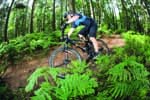 FRAME
FRAME
Top and down tubes on the Gold Series tubeset are externally and internally butted. This means along with the wall thickness changing along the tube’s length, reducing weight while maintaining strength, the external diameter is also increased in high stress areas. This stiffens the front end of the bike while maintaining a comfortable ride that is often lost with the use of full-length oversized tubes. Because of their diameter, it’s also possible to weld both tubes together partially along their length, further improving steering accuracy.
Due to the bike’s design origins — Fisher’s race team — the head tube is short. While this may have been a good thing in allowing racers to get the stretched-out position on an entry-level trail bike, it is not a desired quality. Thankfully, Fisher’s machines come with a stack of spacers under the stem maintaining a decent bar height. It’s effective, if a little ugly.
The shape of the frame, or geometry, is also quite different. Using Genesis geometry, the Marlin has shorter chainstays to improve climbing, placing rider weight over the rear axle. A longer-than-average top tube is paired with a shorter stem to maintain a standard reach, while keeping your body weight further behind the front wheel, reducing the tendency to get spat over the bars on hills.
SUSPENSION
Named Dart 2.5, the RockShox fork is a Dart 2 with added extras. As well as the excellent Turnkey damping, with external adjustment for the rebound damping, the compression-based lockout also allows for minor tuning in this department, on top of its travel limiting properties. Unlike the Suntour fork on the ’Goose, the lockout is based on the damping circuit rather than a mechanical system. If left on accidentally, the fork can still move, preventing damage. Magnesium lowers reduce the weight marginally, but the ability to tune the ride is what sets this fork apart from others.
WHEELS
Fast-rolling Bontrager Jones Xr tyres begin the story, spinning up to speed well thanks to a lack of rolling resistance and reasonably low weight. Rims and disc-ready hubs come from the same stable and do the job. Off-centre drilling for the spoke holes also reduce the dish, evening up spoke tension on each side. In theory this makes for a stronger wheel.
COMPONENTS
More finishing kit from Bontrager, and a full 26in bar is nice to see. Shimano’s Deore level kit supplies nine-speed shifters. While shifting no better than the Alivio on the BeOne, they will last longer and feel more solid.
PERFORMANCE
Frame and fork have the biggest influence on the ride, with the thin-walled tubing noticeably taking the edge off trail bumps, and the superb tuneable fork giving us a ride quality a level above that we expected at this price point.
Genesis geometry always takes a ride to get used to. With the longer front end, steering input is slightly dulled. You cannot manhandle the bike in or out of as many situations. In its favour, though, it was easily the best climbing bike here. Top this with a nine-speed drivetrain and disc-ready wheels, and you have a great machine primed for upgrading.
VERDICT
Gary Fisher has come up with a machine ripe for improvement. A butted tubeset makes a huge difference to the ride, improving comfort. Small-diameter rear stays smooth out the ride further and these are complemented further by the small diameter seatpost. The best fork on test simply knocks the ride up another notch.
The geometry is more suited to covering ground than learning the skills for serious technical trails, but it’s still capable of serious use. It’s just as if the sharp edges of responsiveness have been blunted.
Adding a set of disc brakes at a later date would mean the Fisher could easily compete, on both price and ride, with £500 bikes, and you can’t honestly say that about any other on test.
MBR RATING 9/10



